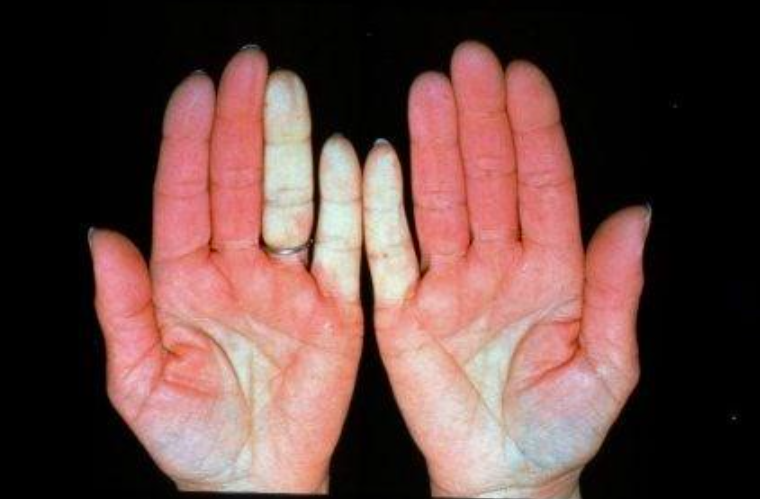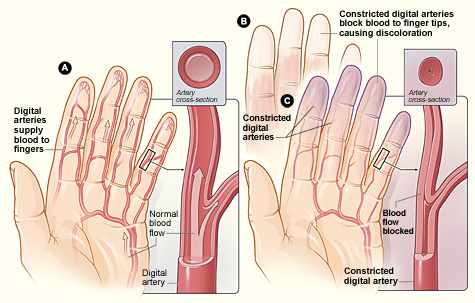
Raynaud’s phenomenon is caused by a vasospasm of the blood vessels resulting in poor blood supply most often to the fingers, and sometimes the toes. This is characterized by white, blue and finally red discolouration. These episodes are usually precipitated by cold exposure, vibration, stress or some vasocontractive drugs. Smoking can also exacerbate the condition.

The cause of Raynaud’s is unknown, however it often occurs with other diseases, such as Rheumatoid Arthritis, Lupus and Scleroderma. It commonly occurs in women between 15 and 45 years old. It tends to be progressive, with episodes beginning in 1 to 2 fingers then becoming more frequent and prolonged, often affecting all fingers, aside from the thumb. It is thought to affect 5-10% of the general population.
Symptoms include cold fingers, change in colour as well as pain. Numbness, tingling and mild swelling may also be present. Episodes usually discontinue upon returning to a warm room or warming the hand. In severe cases ulceration of the digits can occur.
Cold Protection
To avoid episodes of Raynaud’s phenomenon, the entire body should be warm at all times. Follow these tips to avoid getting too cold:
- Dress warmly in layers of loose-fitting clothes, especially during cold weather and during changes of the season.
- Wear a hat in cold weather, because body heat is lost through the scalp. Cover your face and ears with a scarf.
- Wear loose-fitting boots and shoes that won’t cut off the blood circulation.
- Wear heavy socks or layers of socks.
- Wear mittens – they are warmer than gloves. Special “thermoskin” neoprene gloves are available (ask your therapist)
- Always keep a sweater or jacket nearby, even during the summer. It may be cold enough to need it in air-conditioned buildings.
- Use flannel sheets or layers of blankets. Use an electric blanket to warm the sheets before getting into bed. If your hands and feet get cold while sleeping, wear mittens and socks to bed.
- Keep the rooms used most often at a comfortable temperature.
- Start running the bath or shower water well before bathing so you don’t touch the cold water. Keep the bathroom door closed so steam will warm the room.
- Ask family and friends to help. For example, let someone else get the newspaper from outside or start the car on a cold day. Avoid household tasks that require putting hands in cold water or the fridge and freezer.
- Avoid putting your hands in the freezer or visiting the refrigerated section of the supermarket.
- Wear gloves or mittens to reach into the freezer
- Use insulated containers, gloves, or napkins to hold cold drinks or food
- Rinse and peel vegetables with warm water.
- Use chemical heat packs to supplement mittens and warm clothing (e.g. ‘Hot Eze’ heat packs – ask your therapist)
Skin Protection
Poor blood flow can make the skin dry. It may also cause cuts, cracks, or sores to heal more slowly than usual. These tips can help protect the skin:
- Use lotion with lanolin on hands and feet every day to keep the skin from chapping or cracking.
- Use a soap free wash instead of regular soap, e.g. ‘Dermaveen’ or ‘Ego oil’. Clean between fingers and toes, but don’t soak them.
- Examine feet and hands daily to check for ulcers. If an ulcer develops, keep it clean and covered. See a doctor immediately.
- Protect fingernails and toenails. Use a lotion to keep the cuticles soft. Don’t cut the cuticles with scissors or use sharp instruments to push them back. Instead, gently push them back with a cotton bud soaked in cuticle remover. Carefully cut and file your nails in a rounded fashion to the tips of your fingers.
- Wear rubber gloves while washing dishes.
- Take care when doing activities that put pressure on the fingertips, such as using a keyboard or playing the guitar or piano. This kind of pressure may cause your blood vessels to constrict, thus triggering an episode.
- Wear clothes made of natural fibers, such as cotton and wool. These draw moisture away from the skin.
Other Tips:
- Don’t smoke. Chronic smoking causes blood vessels to constrict. Medications to treat Raynaud’s may not be as effective in smokers.
- Try to avoid emotional stress. Ask your therapist about relaxation techniques and other stress reduction methods.